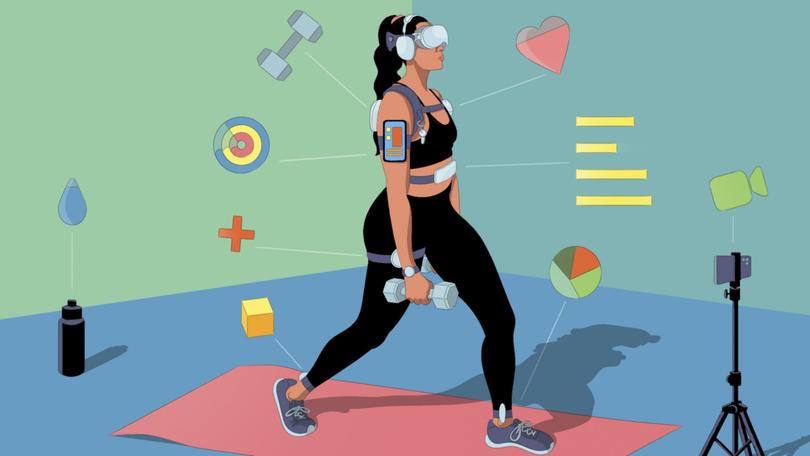TMI, Apple Watch! Why You Don’t Really Need All That Data.

Over the past few years, upping your exercise game has started to feel like getting a degree in data science.
There are glucose monitors and sweat patches, sleep trackers and step trackers, heart rate monitors and cadence sensors. There are watches and rings and armbands and chest straps and clip-on monitors that promise to estimate your VO2 max, your breathing and more.
Even if you don’t use a wearable, if you carry a smartphone, you probably have much of the same data accessible through a health app. Although tracking your workouts is not new, there is now an overwhelming amount of data — the kind once reserved for professional athletes — available to everyday consumers.
Sign up to The Nightly's newsletters.
Get the first look at the digital newspaper, curated daily stories and breaking headlines delivered to your inbox.
By continuing you agree to our Terms and Privacy Policy.But does more data make a better, faster, stronger, healthier human? Can these tools really motivate you, lead to a better annual physical or maximize your workout benefits?
Not all data is good or helpful, doctors, exercise physiologists and coaches say, and having more data does not mean having a more effective workout. The real questions surround not the wearable, but the wearer.
What are wearables?
A wearable is any tracking device worn on your body that measures one or more bodily functions, whether it’s heart rate, sleep time, step count or respiration. Most, including those made by Fitbit, Garmin, Coros, Whoop and Oura, are not considered medical devices and are not regulated or evaluated by the Food and Drug Administration. Indeed, recently, the FDA warned consumers that wearable devices claiming to measure or estimate blood sugar without piercing the skin should not be used for diabetes management.
Regardless, many devices include metrics that are usually collected in a laboratory setting.
For instance, one measurement that can be useful for athletes is your VO2 max, the maximum amount of oxygen that your body can use during intense exercise. The number is usually determined in a lab by exercising at various intensities while wearing a mask that records oxygen consumption and carbon dioxide production. Wearables, however, claim to infer this number using an equation based on your heart rate, which should be taken with a grain of salt, experts said.
Other data, such as step counts and distance traveled, are generally more accurate.
Can they motivate you to exercise more?
“Activity trackers are facilitators, not instigators, of behavior change,” said David Bassett Jr., a professor emeritus of kinesiology, recreation and sport studies at the University of Tennessee in Knoxville.
In other words, the device alone will not make your workouts easier or improve your sleep cycles. But they can help you identify trends in your exercise regimen and track your progress if you are trying to improve.
Researchers who have studied the impact of wearables on behavior have indeed found a correlation between using them and increased movement. But, Bassett added, there’s a sense of accountability when researchers are around.
“Wearables are very good at changing behavior if they are done in the context of a physical activity intervention study,” said Bassett, who has long studied wearables.
That desire to impress people could also be beneficial, according researchers. The app Strava, which tracks workouts and allows users to share their activities, has become ubiquitous for just that. Competitive runners and cyclists often joke, “If it’s not on Strava, did it happen?”
Can they make you a better athlete?
The challenge for athletes looking to up their game with data is finding the type of information that is most helpful, and determining how often they need to reference it. For professionals and those who are new to working out, less is more.
“A beginner and a professional athlete oftentimes use the devices incredibly similarly,” said Darian Allberry, head of user engagement at Coros, a GPS watch company. They want to know how far they’ve gone and how fast they’ve traveled. Beyond that, extra data can be distracting, he added.
This month, Sara Hall, a professional marathon runner competing in the U.S. Olympic marathon trials, actually threw away her GPS watch midrace to avoid distraction. Similarly, for beginner runners, it’s more important to learn to listen to your body’s signals — fatigue, aches, bursts of energy — than to track your pace or heart rate.
It’s middle-of-the-pack athletes — runners and bikers looking to hit a personal best or reach a new milestone — who might get the biggest benefits from wearables, Allberry said.
If you are hoping to run a faster marathon and want to try moderating your pace based on heart rate “zones,” for example, a wearable can help you do so. Bikers who plan their training based on power zones could also use a tracker. If you buy one, though, be sure it fits your needs.
But if you are just trying to get out the door more, a device’s data dump probably isn’t entirely necessary, said Dr. Ethan Weiss, a physician at the University of California, San Francisco.
“We have this attachment to data. We all love data,” Weiss said. “We love to measure things for the sake of measuring things.”
Sometimes he tells his patients that a different item attached at your wrist could better pull you toward more activity.
“Have you considered getting a dog?” he said.
This article originally appeared in The New York Times.
© 2024 The New York Times Company
Originally published on The New York Times
